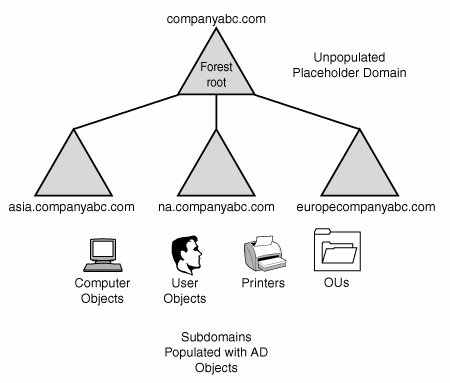Placeholder Domain Model
| The placeholder domain model, also known as the sterile parent domain model, deserves special mention because of its combination of a single namespace/multiple domain model and the peer-root model. Simply put, the placeholder domain model, shown in Figure 5.14, is composed of an unoccupied domain as the forest root, with multiple subdomains populated with user accounts and other objects. Figure 5.14. Unpopulated placeholder domain. There are two distinct advantages to this design. First, as with the peer-root model, the schema is separate from the user domains, thus limiting their exposure and helping to protect the schema. Second, the namespace for the user accounts is consistent in the namespace, thus mitigating any potential political issues. In other words, because all users in all locations are at the same logical level in the domain structure, no one group will feel superior or inferior to another. This issue may seem trite, but the psychological nature of humans is finicky, and you may find that this design offers advantages for certain organizations. A Placeholder Domain Real-World Design ExampleCompany E is an architectural firm with major offices located in New York, Chicago, Los Angeles, Sao Paulo, Rio de Janeiro, Berlin, Paris, London, Tokyo, Singapore, and Hong Kong. Administration is centralized in New York, but regional administration takes place in Rio de Janeiro, London, and Tokyo. The company has recently migrated to Active Directory and has chosen to deploy a placeholder domain model for its organization that looks similar to Figure 5.15. Figure 5.15. Complex Active Directory placeholder domain structure. All users authenticate to geographically centric subdomains. In addition, the administrators in New York have segregated the schema master function into the placeholder domain, limiting its exposure and have limited access to this domain to a small group of high-level administrators. Each domain is logically oriented as well, to give the impression of autonomy to each geographical unit. |
EAN: 2147483647
Pages: 499
